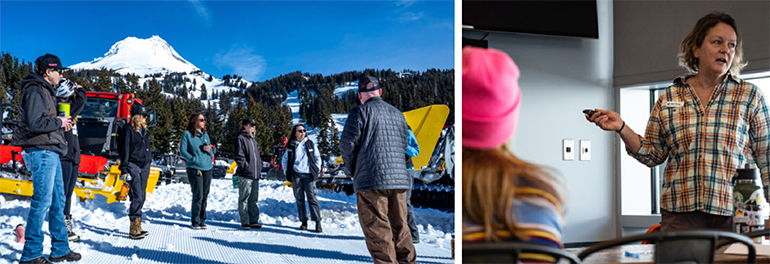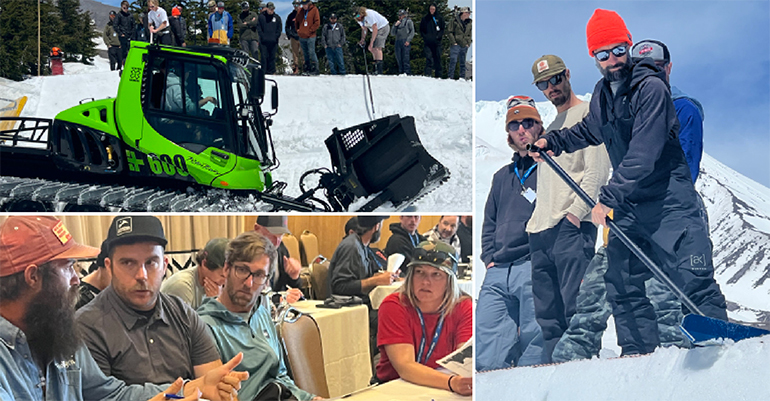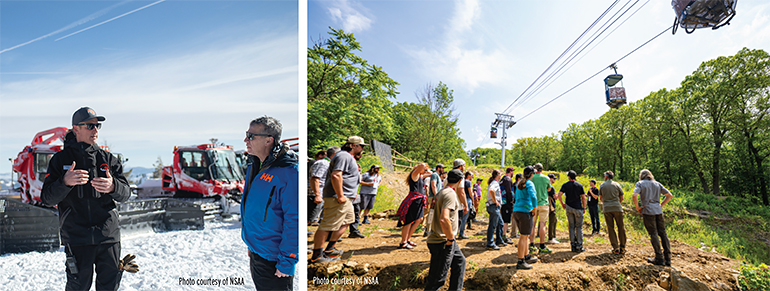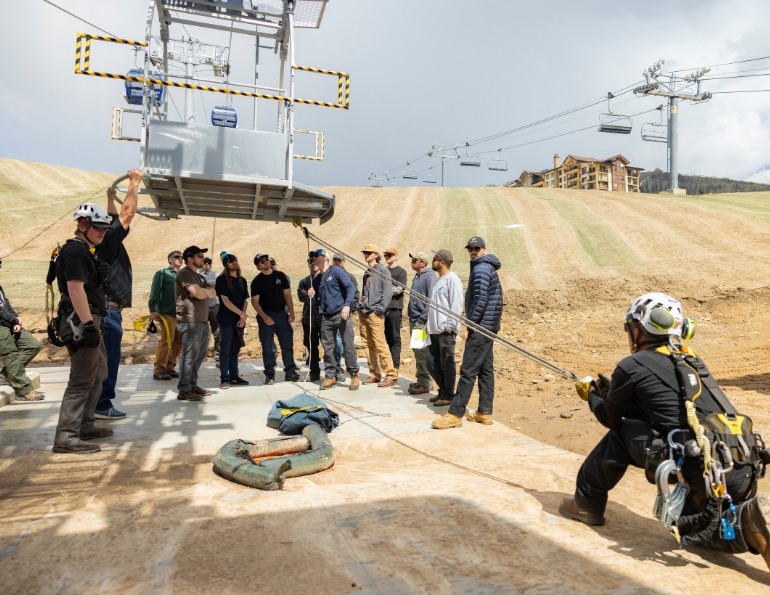Raise your hand if you’ve heard the term “YouTube University” thrown around in your shop. Now, keep it raised if you yourself have said it. (Insert raised hand here.) It’s time to retire this dad joke.
Yes, the internet is a modern-day guru, providing answers whenever we ask for them, day, night, or mid-panic attack on a holiday weekend after a surface lift breaks down. As handy as they are, though, YouTube videos and the MacGyver quick fixes they provide are not realistic or lasting replacements for in-person, hands-on, continuing education.
We generally agree that properly training our mountain operations teams is critical to running a functioning ski area. So, how do we approach training and continuing education in a time when traveling to off-site programs seems more expensive than ever, capital improvement projects at resorts are eating up budgets, and staff turnover continues to be a never-ending battle?
This is the “training conundrum,” a Rubik’s Cube of a problem we need to solve in record fashion in order to retain not only a new generation of workers but those in generations prior who are running on fumes.
THE PIONEERS
At Alterra Mountain Company, the challenges and a potential solution crystalized during the pandemic. “During Covid, we virtually gathered all lift maintenance directors, and it became apparent that existing lift maintenance crews were shrinking,” says Hannah Barrego, director of mountain operations for the company. “Team members were retiring or leaving the ski industry, and the onboarding time was significant for new team members. We needed to create a way to recruit more talent, train employees faster, and retain staff longer.”
Partnership. So, Alterra partnered with Colorado Mountain College (CMC) to develop a 12-credit, on-site, intensive education program titled “Ropeway Mechanical Maintenance Technician: Level 1,” designed to accelerate the learning process of an individual with no lift maintenance knowledge. At the end of the four-week program, which includes classroom learning and hands-on experience, participants can walk away with a Level 1 Lift Mechanic certification.
The pilot session in May of 2023 brought 14 participants, representing all of Alterra’s North American resorts, to Steamboat, Colo. The costs of the credits, travel, housing, and transportation were paid for by Alterra. And thanks to CMC’s Amy Smallwood, and adjunct professors Luke Matejka, Pete McKinnon, and John Holm, all 14 students completed the course and had positive things to say.
“We interviewed students throughout the course,” says Barrego, “and the resounding feedback was that the course provided them with foundational knowledge to better perform their jobs at their home resort.”
The program also offered students something they don’t always get—an opportunity to ask questions. “Some of the most encouraging feedback that I received was that our adjunct faculty created an environment that was safe and accepting, and students felt like they could ask anything to these experts and each other,” she says. “When learning on-the-job, you can’t always slow down and ask the 30-plus-year lift maintenance vet the questions that you want to ask because you are moving quickly.”
Growing the program. Based on the success of that first session, Barrego is now working with her team to grow the program. “We are working to build and deploy a Level 2 course as well,” she says, “which would give participants the hours needed to register with the Department of Labor for a formal apprenticeship program. So, graduates would not only get their Level 2 but would also be a journeyman at the end of the course.”
The goal, overall, of the program is to benefit the greater industry by attracting new talent to mountain operations and providing that talent with a career pathway that could someday include an associate degree.
THE BOOTSTRAPPERS
Other operators agree: We need more of this kind of hands-on education. When asked what kind of maintenance ops training programs are missing from our industry, Ross Boisvert, president and GM of small independent ski area McIntyre in southern New Hampshire, noted a need for more grassroots training opportunities and how-to sessions to fill the widening gaps in generational knowledge. “We have a lot of younger people coming in, and the how-to sessions are key,” he says.
Creating a program like Alterra’s from scratch may not be realistic for independent ski areas. However, demand is there, and many grassroots training efforts have popped up around the country to meet that demand.
Training with a focus. This past season, Allison Marriner, park and slope grooming manager for Mt. Hood Meadows, Ore., created She Grooms, a low-cost yet impactful women’s grooming conference—and the first of its kind.
 Left to right: Grassroots women’s grooming conference She Grooms had its inaugural session this April at Mt. Hood Meadows, Ore. Twenty-six women participated in the skill-building and networking event.
Left to right: Grassroots women’s grooming conference She Grooms had its inaugural session this April at Mt. Hood Meadows, Ore. Twenty-six women participated in the skill-building and networking event.
Marriner describes it as “an event that provides networking, skill building, and mentorship, and creates pathways for women in the industry.” The inaugural two-day conference hosted this April at Mt. Hood Meadows offered hands-on snowcat training, roundtable discussions, and networking opportunities.
In its first year, the event attracted 26 women from ski areas in Colorado, California, Idaho, Washington, British Columbia, and Oregon on relatively short notice when it was announced late in the season. That participants eagerly rallied to attend the new event reflects a desire for educational gatherings with a focus. Notably, the program also saw “a combination of current industry professionals and those interested in getting into the field,” says Marriner, demonstrating its recruiting potential as well.
As for next steps, “We would like to see it become an annual event that can accommodate more participants, offer more classes, and [provide more] hands-on operation and skills training,” says Marriner. She also hopes to expand the concept to include other mountain operations departments such as snowmaking, lift maintenance, vehicle maintenance, and patrol.
THE INVESTORS
While demand for hands-on education is high, budget limitations and other operational obstacles impact the type and quantity of training mountain ops employees receive. “The hard part for us,” says McIntyre’s Boisvert, “is we are a small resort and have a lot going on in the winter and summer. Our departments sometimes get caught up in projects, and scheduling conflicts with some educational events make it difficult to attend.”
The location and cost of a training opportunity can influence who and how many get to attend as well. For example, says Boisvert, “We do adjust [how many staff attend] each year for the NSAA National Convention depending on where it is held.”
Making it a priority. Even with those challenges, says Boisvert, “We always make room in the budget for training programs. It is important to be flexible on spending when it comes to education. When we have a team member come with the desire to attend an educational event, we do our best to make it happen.”
Early in his career, Boisvert recalls, “I paid for training programs personally. Then, I would come back and share what was presented and what I learned.” Now, as a GM, he makes staff education a priority. “Our team members attend just about everything we can. We attend the NSAA National Convention, our regional fall educational series, LMS, the Ski NH annual meeting, and more.”
Why? Continuing education helps with staff retention. “Any time there is investment in team members, it creates comradery and a feeling of belonging,” says Boisvert. It also strengthens the team’s depth of knowledge and improves operations—for example, a staff member that Boisvert sent in 2022 to SAM’s annual Cutter’s Camp, a hands-on terrain park grooming event hosted at Timberline Lodge, Ore., each spring, now serves as McIntyre’s park manager and has created events that have attracted pro riders to the ski area. “This is a success story of investing in your team,” says Boisvert.
 Cutter’s Camp campers learn park building skills on the snow at Timberline Lodge, Ore. (left), and have the opportunity to network and idea-share in classroom settings (above). While many resort operators send their groomers to camp as part of the company training budget, some campers have paid their own way to expand on limited training received at their home resorts.
Cutter’s Camp campers learn park building skills on the snow at Timberline Lodge, Ore. (left), and have the opportunity to network and idea-share in classroom settings (above). While many resort operators send their groomers to camp as part of the company training budget, some campers have paid their own way to expand on limited training received at their home resorts.
Training provides networking opportunities as well. “One of the greatest resources we all have when attending events and training programs is networking,” says Boisvert. “When talking with someone from another resort, you might learn how to do something differently, or realize they have the same lifts you do and talk about how they fix a certain issue. You never know what you might learn talking with someone.”
THE SELF-STARTERS
But what happens when the resort you work for isn’t willing or doesn’t have the means to pay for your continuing education? Many employees settle for valuable but rushed on-the-job learning and keep their fingers crossed that next year’s budget will allow for new opportunities. Others, who feel a strong need to pursue outside training and have room in their personal budgets, foot the bill themselves.
One attendee of SAM’s Cutter’s Camp says of paying his own way, “I made the trip out to Oregon because I truly want to be better at what I love to do.”
Looking for support. A part-time free groomer at a mid-sized East Coast ski area, the attendee says he “didn’t bother asking if they (his employer) would cover the cost” because when he told his supervisor about his desire to attend, the supervisor did not see the value in participating in a terrain park-focused event as a trail groomer.
That position may have been shortsighted, suggests the free groomer, who says, “I learned some new techniques [in an on-hill session] that I can use next season. The breakout sessions were eye opening, and I have a new appreciation for all the hard work that goes into the park side of the business.”
When chatting with employees who are hungry for new skills and lacking support, the recurring theme is a sense of frustration with minimal internal training. The free groomer says a key reason for wanting to attend Cutter’s Camp was that his “official training” at his home resort included roughly four ride-alongs and an online HR video related to standard handbook items—that was it.
While the groomer paid his own way to Cutter’s Camp, such self-starters—aka those willing and able to pay for their own training—don’t always exist and will never exist in the numbers we need to keep our cats running, our lifts spinning, and our snow guns blasting.
THE HELPERS
For ski areas working with tight margins, there are helping hands to offset training costs. For example, the Mountain Foundation, a 501(c)3 scholarship fund founded by the National Ski Areas Association (NSAA) in 2019, aims to grant $50,000 annually to employees looking to attend industry education programs. (A full list of applicable programs and conferences is available at nsaa.org.)
 Attendees of NSAA’s Western Winter Conference, held at Palisades Tahoe, Calif., in January (above), and the NSAA Downhill Bike Park Summit, hosted this summer at Mountain Creek, N.J. (right), are eligible to apply for Mountain Foundation scholarships.
Attendees of NSAA’s Western Winter Conference, held at Palisades Tahoe, Calif., in January (above), and the NSAA Downhill Bike Park Summit, hosted this summer at Mountain Creek, N.J. (right), are eligible to apply for Mountain Foundation scholarships.
The Foundation was conceptualized at a 2018 NSAA board meeting by Blaise Carrig, senior advisor to the Vail Resorts Mountain Division at the time, as a way to “provide other ‘up-and-comers’ the opportunity to attend education events to help them grow into the future leaders of snowsports,” says NSAA president and CEO Kelly Pawlak. Education events played an important role in Carrig’s own career, opening the door to new possibilities and connections, Pawlak adds.
With $50,000 available annually, “The Mountain Foundation gets a wide variety of applicants, mostly middle management or staff members who are just starting out in a supervisory capacity,” says Pawlak. She hopes to see more—more applicants and more resorts helping to train this next chapter of leadership.
New trainers needed. “We are currently losing a generation of mountain operations trainers and educators due to retirement,” says Pawlak. “Unfortunately, there is not a strong bench to backfill this shift. We need all ski areas to recognize strong trainers and educators, or those that show potential or an interest, to work with NSAA so we can help develop those people into the next generation of industry presenters and educators.”
THE SOLUTIONS?
Will we pass on the knowledge in time or be left scrambling? How can we keep up with demand for new training programs? How can we afford elevated continuing education experiences for all our employees? Sometimes, the challenges seem overwhelming.
E-learning. New avenues for continuing education are emerging to meet the need as we speak. Along with the new in-person classes and events, e-learning courses—a lifeline during the pandemic—are continuing to evolve, expanding easier access to knowledge.
“Now we offer e-learning courses for terrain park operators, patrol, snowmobile operators, mountain bike operations, and the newest course is specific to lift operators,” says Mike Bettera, president and CEO of Effective Edge and LVL Up Academy. “This course will be in Spanish as well, which will make it more inclusive for all our staff, no matter where on the globe they come from.”
Such e-learning offerings have recruitment potential as well. “We partnered with Burton’s Chill Graduate Program and offered our ‘Terrain Park Fundamentals of Operations 101’ course for free to this group,” says Bettera. “We hope that receiving a certificate upon course completion provides these students an understanding that there is opportunity in our industry, a path to a career, and gives them a leg up in the hiring process. To be able to provide free training before they even get hired is an absolute win for us all.”
As a community, the snowsports industry holds some of the most dedicated, resourceful, and hardworking people around. The rising tide of innovative new training offerings and the swelling recognition of the need for more and better training opportunities will lift all boats.
Information sharing. To bring new generations of workers into our community and help our businesses thrive, we must continue to find ways to share the information our seasoned team members have gained through experience.
“I consider myself lucky to be able to work with a few team members that have been grooming for close to 30 years,” says the free groomer who was willing to pay his own way. “When they share wisdom, I am all ears. That real-world experience-sharing is operator gold dust. Someday, my hope is to be that seasoned operator that can pass down that gold dust to the next generation of operators.”






